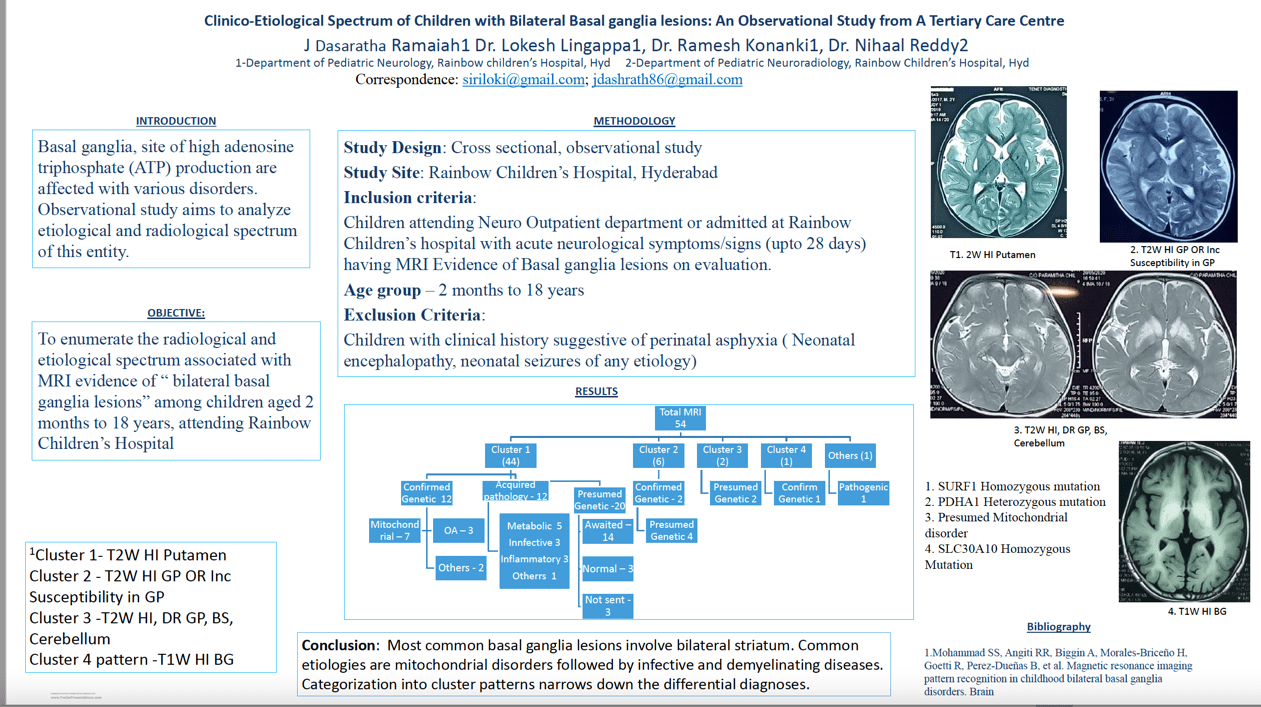Clinico-Etiological Spectrum of Children with Bilateral Basal ganglia lesions: An Observational Study from A Tertiary Care Centre
DASARATHA RAMAIAH JINKA, LOKESH LINGAPPA, RAMESH KONANKI, NIHAAL REDDY
Background: Basal ganglia, site of high adenosine triphosphate (ATP) production is affected with various disorders. Observational study aims to analyze etiological and radiological spectrum of this entity.
Methodology: We enrolled children from 2months to 18 yr of age with bilateral basal ganglia lesions from August,2020 to December,2021. Exclusion- perinatal asphyxia and kernicterus.
Results: 46 children were enrolled. MRI in 41 and CT Brain in 5. 25/41 had definitive diagnoses. 13 had confirmed genetic diagnoses, 12 acquired pathologies, 5 presumed genetic etiology with WES/CES negative, 9 presumed genetic etiology-test not sent or report awaited. MRI were categorized into 4 clusters of basal ganglia lesions (1) Cluster 1- T2W HI Putamen (34/41), cluster 2 - T2W HI GP OR Inc Susceptibility in GP (4/41), cluster 3 -T2W HI, DR GP, BS, Cerebellum (1/41) and cluster 4 pattern -T1W HI BG (1/41). Mitochondrial disorders (7/11) and organic acidemias (2/11) in cluster one. Nutritional thiamine deficiency, Jap B encephalitis, Rickettsial infection, MOGAD are among non-genetic diagnoses in cluster 1 pattern. In cluster 2, one each pyruvate dehydrogenase e1 alpha deficiency and GAMT mutation. Custer 3- acquired thiamine deficiency. cluster 4 one had SLC30A10 pathogenic variant. 1 with substantial nigra and thalamus not fitting the clusters had MTO1 mutation. Cluster distribution is similar to study by Mohammad et al.
Conclusion: Most common basal ganglia lesions involve bilateral striatum with mitochondrial disorders followed by infective and demyelinating diseases. Categorization into cluster patterns narrows down the differential diagnoses.
Keywords: Basal ganglia, neuroimaging
DASARATHA RAMAIAH JINKA
RAINBOW CHILDREN'S HOSPITAL
India
LOKESH LINGAPPA
RAINBOW CHILDREN'S HOSPITAL
India
RAMESH KONANKI
RAINBOW CHILDREN'S HOSPITAL
India
NIHAAL REDDY
RAINBOW CHILDREN'S HOSPITAL
India
Background: Basal ganglia, site of high adenosine triphosphate (ATP) production is affected with various disorders. Observational study aims to analyze etiological and radiological spectrum of this entity.
Methodology: We enrolled children from 2months to 18 yr of age with bilateral basal ganglia lesions from August,2020 to December,2021. Exclusion- perinatal asphyxia and kernicterus.
Results: 46 children were enrolled. MRI in 41 and CT Brain in 5. 25/41 had definitive diagnoses. 13 had confirmed genetic diagnoses, 12 acquired pathologies, 5 presumed genetic etiology with WES/CES negative, 9 presumed genetic etiology-test not sent or report awaited. MRI were categorized into 4 clusters of basal ganglia lesions (1) Cluster 1- T2W HI Putamen (34/41), cluster 2 - T2W HI GP OR Inc Susceptibility in GP (4/41), cluster 3 -T2W HI, DR GP, BS, Cerebellum (1/41) and cluster 4 pattern -T1W HI BG (1/41). Mitochondrial disorders (7/11) and organic acidemias (2/11) in cluster one. Nutritional thiamine deficiency, Jap B encephalitis, Rickettsial infection, MOGAD are among non-genetic diagnoses in cluster 1 pattern. In cluster 2, one each pyruvate dehydrogenase e1 alpha deficiency and GAMT mutation. Custer 3- acquired thiamine deficiency. cluster 4 one had SLC30A10 pathogenic variant. 1 with substantial nigra and thalamus not fitting the clusters had MTO1 mutation. Cluster distribution is similar to study by Mohammad et al.
Conclusion: Most common basal ganglia lesions involve bilateral striatum with mitochondrial disorders followed by infective and demyelinating diseases. Categorization into cluster patterns narrows down the differential diagnoses.
Keywords: Basal ganglia, neuroimaging
DASARATHA RAMAIAH JINKA
RAINBOW CHILDREN'S HOSPITAL
India
LOKESH LINGAPPA
RAINBOW CHILDREN'S HOSPITAL
India
RAMESH KONANKI
RAINBOW CHILDREN'S HOSPITAL
India
NIHAAL REDDY
RAINBOW CHILDREN'S HOSPITAL
India

DASARATHA RAMAIAH JINKA
RAINBOW CHILDREN'S HOSPITAL
India
RAINBOW CHILDREN'S HOSPITAL
India